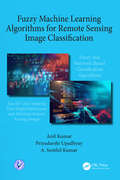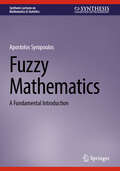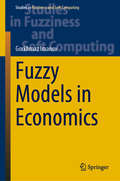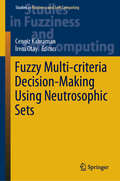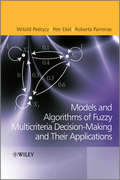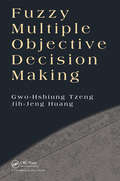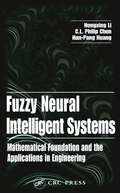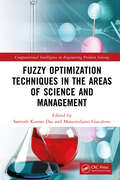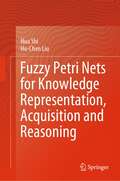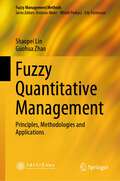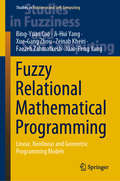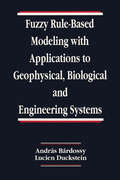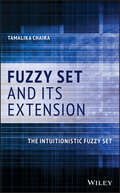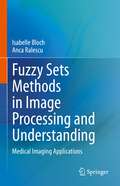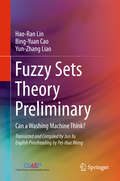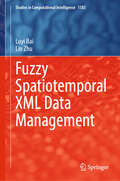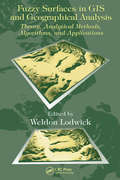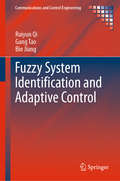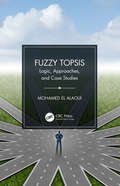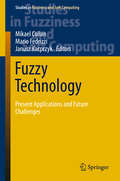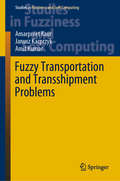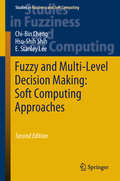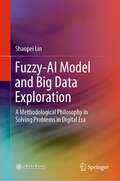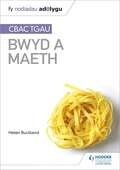- Table View
- List View
Fuzzy Machine Learning Algorithms for Remote Sensing Image Classification
by Anil Kumar A. Senthil Kumar Priyadarshi UpadhyayThis book covers the state-of-art image classification methods for discrimination of earth objects from remote sensing satellite data with an emphasis on fuzzy machine learning and deep learning algorithms. Both types of algorithms are described in such details that these can be implemented directly for thematic mapping of multiple-class or specific-class landcover from multispectral optical remote sensing data. These algorithms along with multi-date, multi-sensor remote sensing are capable to monitor specific stage (for e.g., phenology of growing crop) of a particular class also included. With these capabilities fuzzy machine learning algorithms have strong applications in areas like crop insurance, forest fire mapping, stubble burning, post disaster damage mapping etc. It also provides details about the temporal indices database using proposed Class Based Sensor Independent (CBSI) approach supported by practical examples. As well, this book addresses other related algorithms based on distance, kernel based as well as spatial information through Markov Random Field (MRF)/Local convolution methods to handle mixed pixels, non-linearity and noisy pixels. Further, this book covers about techniques for quantiative assessment of soft classified fraction outputs from soft classification and supported by in-house developed tool called sub-pixel multi-spectral image classifier (SMIC). It is aimed at graduate, postgraduate, research scholars and working professionals of different branches such as Geoinformation sciences, Geography, Electrical, Electronics and Computer Sciences etc., working in the fields of earth observation and satellite image processing. Learning algorithms discussed in this book may also be useful in other related fields, for example, in medical imaging. Overall, this book aims to: exclusive focus on using large range of fuzzy classification algorithms for remote sensing images; discuss ANN, CNN, RNN, and hybrid learning classifiers application on remote sensing images; describe sub-pixel multi-spectral image classifier tool (SMIC) to support discussed fuzzy and learning algorithms; explain how to assess soft classified outputs as fraction images using fuzzy error matrix (FERM) and its advance versions with FERM tool, Entropy, Correlation Coefficient, Root Mean Square Error and Receiver Operating Characteristic (ROC) methods and; combines explanation of the algorithms with case studies and practical applications.
Fuzzy Mathematics: A Fundamental Introduction (Synthesis Lectures on Mathematics & Statistics)
by Apostolos SyropoulosThis book aims to introduce readers without a strong mathematical background to the basic ideas of fuzzy set theory and logic. Fuzzy mathematics is the mathematics of vagueness, a universal property of this world. There are many objects that are called vague because they cannot be precisely defined. Since vagueness is so common, a tool is needed to describe it and to effectively deal with it. Fuzzy mathematics is such a tool, and it is used by most researchers and scholars. As such, this book provides a short overview of the field written for non-specialists. This book allows readers to delve into the theory of fuzzy sets and introduces core mathematical ideas without using the usual formalities of books in mathematics, i.e. theorems, proofs, etc.
Fuzzy Models in Economics (Studies in Fuzziness and Soft Computing #402)
by Gorkhmaz ImanovThis book offers a timely guide to fuzzy methods applied to the analysis of socioeconomic systems. It provides readers with a comprehensive and up-to-date overview of the algorithms, including the theory behind them, as well as practical considerations, current limitations and solutions. Each chapter focuses on a different economic problem, explaining step by step the process to approach it, using the corresponding fuzzy tools. The book covers elements of intuitionistic fuzzy logics, fuzzy entropy and the fuzzy DEMATEL method, a fuzzy approach to calculate the financial stability index. It also reports on some new models of social, financial and ecological security, and on a novel fuzzy method for evaluating the quality of development of information economy.
Fuzzy Multi-criteria Decision-Making Using Neutrosophic Sets
by Cengiz Kahraman İrem OtayThis book offers a comprehensive guide to the use of neutrosophic sets in multiple criteria decision making problems. It shows how neutrosophic sets, which have been developed as an extension of fuzzy and paraconsistent logic, can help in dealing with certain types of uncertainty that classical methods could not cope with. The chapters, written by well-known researchers, report on cutting-edge methodologies they have been developing and testing on a variety of engineering problems. The book is unique in its kind as it reports for the first time and in a comprehensive manner on the joint use of neutrosophic sets together with existing decision making methods to solve multi-criteria decision-making problems, as well as other engineering problems that are complex, hard to model and/or include incomplete and vague data. By providing new ideas, suggestions and directions for the solution of complex problems in engineering and decision making, it represents an excellent guide for researchers, lecturers and postgraduate students pursuing research on neutrosophic decision making, and more in general in the area of industrial and management engineering.
Fuzzy Multicriteria Decision-Making
by Witold Pedrycz Petr Ekel Roberta ParreirasFuzzy Multicriteria Decision-Making: Models, Algorithms and Applications addresses theoretical and practical gaps in considering uncertainty and multicriteria factors encountered in the design, planning, and control of complex systems. Including all prerequisite knowledge and augmenting some parts with a step-by-step explanation of more advanced concepts, the authors provide a systematic and comprehensive presentation of the concepts, design methodology, and detailed algorithms. These are supported by many numeric illustrations and a number of application scenarios to motivate the reader and make some abstract concepts more tangible.Fuzzy Multicriteria Decision-Making: Models, Algorithms and Applications will appeal to a wide audience of researchers and practitioners in disciplines where decision-making is paramount, including various branches of engineering, operations research, economics and management; it will also be of interest to graduate students and senior undergraduate students in courses such as decision making, management, risk management, operations research, numerical methods, and knowledge-based systems.
Fuzzy Multiple Objective Decision Making
by Gwo-Hshiung Tzeng Jih-Jeng HuangMulti-objective programming (MOP) can simultaneously optimize multi-objectives in mathematical programming models, but the optimization of multi-objectives triggers the issue of Pareto solutions and complicates the derived answers. To address these problems, researchers often incorporate the concepts of fuzzy sets and evolutionary algorithms into M
Fuzzy Neural Intelligent Systems: Mathematical Foundation and the Applications in Engineering
by Hongxing Li Han-Pang Huang C.L. Philip ChenAlthough fuzzy systems and neural networks are central to the field of soft computing, most research work has focused on the development of the theories, algorithms, and designs of systems for specific applications. There has been little theoretical support for fuzzy neural systems, especially their mathematical foundations. Fuzzy Neural Intelligent Systems fills this gap. It develops a mathematical basis for fuzzy neural networks, offers a better way of combining fuzzy logic systems with neural networks, and explores some of their engineering applications. Dividing their focus into three main areas of interest, the authors give a systematic, comprehensive treatment of the relevant concepts and modern practical applications:Fundamental concepts and theories for fuzzy systems and neural networks.Foundation for fuzzy neural networks and important related topicsCase examples for neuro-fuzzy systems, fuzzy systems, neural network systems, and fuzzy-neural systemsSuitable for self-study, as a reference, and ideal as a textbook, Fuzzy Neural Intelligent Systems is accessible to students with a basic background in linear algebra and engineering mathematics. Mastering the material in this textbook will prepare students to better understand, design, and implement fuzzy neural systems, develop new applications, and further advance the field.
Fuzzy Optimization Techniques in the Areas of Science and Management (Computational Intelligence in Engineering Problem Solving)
by Santosh Kumar Das Massimiliano GiacaloneThis book helps to enhance the application of fuzzy logic optimization in the areas of science and engineering. It includes implementation and modeling paradigms such as path planning and routing design for different wireless networks, organization behavior strategies modeling, and so forth. It also: Explains inventory control management, uncertainties management, loss minimization, game optimization, data analysis and prediction, and different decision-making system and management, and so forth. Describes applicability of fuzzy optimization techniques in areas of science and management. Resolves several issues based on uncertainty using member function. Helps to map different problems based on mathematical modelling. Includes issues and problems based on linear and non-linear optimizations. Focuses on management science such as manpower management and inventory planning. This book is aimed at researchers and graduate students in signal processing, power systems, systems and industrial engineering, and computer networks.
Fuzzy Petri Nets for Knowledge Representation, Acquisition and Reasoning
by Hu-Chen Liu Hua ShiThis book provides valuable knowledge, useful fuzzy Petri nets (FPN) models, and practical examples that can be considered by mangers in supporting knowledge management of organizations to increase and sustain their competitive advantages. In this book, the authors proposed various improved FPN models to enhance the modeling power and applicability of FPNs in knowledge representation and reasoning. This book is useful for practitioners and researchers working in the fields of knowledge management, operation management, information science, industrial engineering, and management science. It can also be used as a textbook for postgraduate and senior undergraduate students.
Fuzzy Quantitative Management: Principles, Methodologies and Applications (Fuzzy Management Methods)
by Shaopei Lin Guohua ZhaoThis book is devoted to fuzzy quantitative studies in managerial science, discussing the philosophical background and decision-making essentials. For reference, a series of practical examples illustrate broad areas of application that are important in project risk management problems, and in complicated mega projects. Using computers to simulate human intelligence with fuzzy approaches is the basis of “Fuzzy-AI model,” which offers an efficient tool capable of simulating human intelligence in order to perform digitized decision inference and quantitative information management.
Fuzzy Relational Mathematical Programming: Linear, Nonlinear and Geometric Programming Models (Studies in Fuzziness and Soft Computing #389)
by Bing-Yuan Cao Ji-Hui Yang Xue-Gang Zhou Zeinab Kheiri Faezeh Zahmatkesh Xiao-Peng YangThis book summarizes years of research in the field of fuzzy relational programming, with a special emphasis on geometric models. It discusses the state-of-the-art in fuzzy relational geometric problems, together with key open issues that must be resolved to achieve a more efficient application of this method. Though chiefly based on research conducted by the authors, who were the first to introduce fuzzy geometric problems, it also covers important findings obtained in the field of linear and non-linear programming. Thanks to its balance of basic and advanced concepts, and its wealth of practical examples, the book offers a valuable guide for both newcomers and experienced researcher in the fields of soft computing and mathematical optimization.
Fuzzy Rule-Based Modeling with Applications to Geophysical, Biological, and Engineering Systems (Systems Engineering Ser.)
by Lucien Duckstein Andras BardossyThis book presents in a systematic and comprehensive manner the modeling of uncertainty, vagueness, or imprecision, alias "fuzziness," in just about any field of science and engineering. It delivers a usable methodology for modeling in the absence of real-time feedback.The book includes a short introduction to fuzzy logic containing basic definitions of fuzzy set theory and fuzzy rule systems. It describes methods for the assessment of rule systems, systems with discrete response sets, for modeling time series, for exact physical systems, examines verification and redundancy issues, and investigates rule response functions.Definitions and propositions, some of which have not been published elsewhere, are provided; numerous examples as well as references to more elaborate case studies are also given. Fuzzy rule-based modeling has the potential to revolutionize fields such as hydrology because it can handle uncertainty in modeling problems too complex to be approached by a stochastic analysis. There is also excellent potential for handling large-scale systems such as regionalization or highly non-linear problems such as unsaturated groundwater pollution.
Fuzzy Set and Its Extension: The Intuitionistic Fuzzy Set
by Tamalika ChairaProvides detailed mathematical exposition of the fundamentals of fuzzy set theory, including intuitionistic fuzzy sets This book examines fuzzy and intuitionistic fuzzy mathematics and unifies the latest existing works in literature. It enables readers to fully understand the mathematics of both fuzzy set and intuitionistic fuzzy set so that they can use either one in their applications. Each chapter of Fuzzy Set and Its Extension: The Intuitionistic Fuzzy Set begins with an introduction, theory, and several examples to guide readers along. The first one starts by laying the groundwork of fuzzy/intuitionistic fuzzy sets, fuzzy hedges, and fuzzy relations. The next covers fuzzy numbers and explains Zadeh's extension principle. Then comes chapters looking at fuzzy operators; fuzzy similarity measures and measures of fuzziness; and fuzzy/intuitionistic fuzzy measures and fuzzy integrals. The book also: discusses the definition and properties of fuzzy measures; examines matrices and determinants of a fuzzy matrix; and teaches about fuzzy linear equations. Readers will also learn about fuzzy subgroups. The second to last chapter examines the application of fuzzy and intuitionistic fuzzy mathematics in image enhancement, segmentation, and retrieval. Finally, the book concludes with coverage the extension of fuzzy sets. This book: Covers both fuzzy and intuitionistic fuzzy sets and includes examples and practical applications Discusses intuitionistic fuzzy integrals and recent aggregation operators using Choquet integral, with examples Includes a chapter on applications in image processing using fuzzy and intuitionistic fuzzy sets Explains fuzzy matrix operations and features examples Fuzzy Set and Its Extension: The Intuitionistic Fuzzy Set is an ideal text for graduate and research students, as well as professionals, in image processing, decision-making, pattern recognition, and control system design.
Fuzzy Sets Methods in Image Processing and Understanding: Medical Imaging Applications
by Isabelle Bloch Anca RalescuThis book provides a thorough overview of recent methods using higher level information (object or scene level) for advanced tasks such as image understanding along with their applications to medical images. Advanced methods for fuzzy image processing and understanding are presented, including fuzzy spatial objects, geometry and topology, mathematical morphology, machine learning, verbal descriptions of image content, fusion, spatial relations, and structural representations. For each methodological aspect covered, illustrations from the medical imaging domain are provided. This is an ideal book for graduate students and researchers in the field of medical image processing.
Fuzzy Sets Theory Preliminary: Can A Washing Machine Think?
by Bing-Yuan Cao Hao-Ran Lin Yun-Zhang LiaoThis basic book has been used at the middle schools in Shanghai, China for more than 10 years. The book presents carefully-selected contents in order to achieve the roles of enlightenment and popularization. It mainly includes: Chapter 1: Human Brains, Computers and Fuzzy Mathematics; Chapter 2: Matrix, Fuzzy Relations and Fuzzy Matrix; Chapter 3: Fuzzy Control; Chapter 4: Fuzzy Statistics and Fuzzy Probability and Chapter 5: Fuzzy Linear Programming. It includes at the end of each chapter concise, interesting and profound reading and thinking materials, and a certain amount of exercises so as to make it an informative and interesting textbook. This book can be used not only as a textbook in senior middle schools, and in vocational colleges, but also as a primer for individually learning fuzzy mathematics.
Fuzzy Spatiotemporal XML Data Management (Studies in Computational Intelligence #1183)
by Luyi Bai Lin ZhuSpatiotemporal data is not always precise, and fuzziness in spatiotemporal data is usually accepted because of the way the world is measured and represented. Although eXtensible Markup Language (XML) recommended by the World Wide Web Consortium (W3C) has become the de-facto standard for data representation and exchange on the Web, an edited collection of fuzzy spatiotemporal XML data management studies is still scarce. This book studies fuzzy XML approaches for spatiotemporal data management that can greatly enhance the utilization of this sort of data for spatiotemporal applications. The book is anticipated to serve as a valuable resource in this field and is expected to attract considerable interest from researchers and developers engaged in the applications within the domain of spatiotemporal data management.
Fuzzy Surfaces in GIS and Geographical Analysis: Theory, Analytical Methods, Algorithms and Applications
by Weldon LodwickSurfaces are a central to geographical analysis. Their generation and manipulation are a key component of geographical information systems (GISs). However, geographical surface data is often not precise. When surfaces are used to model geographical entities, the data inherently contains uncertainty in terms of both position and attribute. Fuzzy
Fuzzy System Identification and Adaptive Control (Communications and Control Engineering)
by Bin Jiang Ruiyun Qi Gang TaoThis book provides readers with a systematic and unified framework for identification and adaptive control of Takagi–Sugeno (T–S) fuzzy systems. Its design techniques help readers applying these powerful tools to solve challenging nonlinear control problems. The book embodies a systematic study of fuzzy system identification and control problems, using T–S fuzzy system tools for both function approximation and feedback control of nonlinear systems. Alongside this framework, the book also: introduces basic concepts of fuzzy sets, logic and inference system; discusses important properties of T–S fuzzy systems; develops offline and online identification algorithms for T–S fuzzy systems; investigates the various controller structures and corresponding design conditions for adaptive control of continuous-time T–S fuzzy systems; develops adaptive control algorithms for discrete-time input–output form T–S fuzzy systems with much relaxed design conditions, and discrete-time state-space T–S fuzzy systems; and designs stable parameter-adaptation algorithms for both linearly and nonlinearly parameterized T–S fuzzy systems. The authors address adaptive fault compensation problems for T–S fuzzy systems subject to actuator faults. They cover a broad spectrum of related technical topics and to develop a substantial set of adaptive nonlinear system control tools. Fuzzy System Identification and Adaptive Control helps engineers in the mechanical, electrical and aerospace fields, to solve complex control design problems. The book can be used as a reference for researchers and academics in nonlinear, intelligent, adaptive and fault-tolerant control.
Fuzzy TOPSIS: Logic, Approaches, and Case Studies
by Mohamed El AlaouiThis book aims to justify the use of fuzzy logic as a logic and as a theory in the decision-making context. It also discusses the development of the TOPSIS method (Technique for Order of Preference by Similarity to Ideal Solution) with related examples and MATLAB codes. This is the first book devoted to TOPSIS and its fuzzy versions. It presents the use of fuzzy logic as a logic and as a theory in the decision-making content and discusses the development of the TOPSIS method in classical and fuzzy context. The book justifies the use of fuzzy logic as an uncertainty theory and provides illustrative examples for each fuzzy TOPSIS extension, along with related MATLAB codes and case studies. This book is for Industrial Engineers, Operations Research Engineers, Systems Engineers, and Production Engineers working in the areas of Decision Analysis, Multi-Criteria Decision Making, and Multiple Objective Optimization.
Fuzzy Technology
by Mikael Collan Mario Fedrizzi Janusz KacprzykThisbook provides readers with a timely and comprehensive yet concise view on the field of fuzzy logic and its real-world applications. The chapters, writtenby authoritative scholars in the field, report on promising new models for dataanalysis, decision making, and systems modeling, with a special emphasis on theirapplications in management science. The book is a token of appreciation from the fuzzy researchcommunity to Professor Christer Carlsson for his long time research and organizationalcommitment, which have among other things resulted in the foundation and success of theInstitute for Advanced Management Systems Research (IAMSR) at Åbo Akademi University, in Åbo(Turku), Finland. The book serves as timely guide for the fuzzy logic andoperations research communities alike.
Fuzzy Transportation and Transshipment Problems (Studies in Fuzziness and Soft Computing #385)
by Amit Kumar Janusz Kacprzyk Amarpreet KaurThis book presents a novel approach to the formulation and solution of three classes of problems: the fully fuzzy transportation problem, the fully fuzzy transshipment problem, and fully fuzzy solid transportation problem. It points out some limitations of the existing formulations and approaches, indicating some possible, conceptually and algorithmically attractive solutions to alleviate them. In particular, the book describes new conceptual and algorithmic solutions for finding the fuzzy optimal solutions of the single-objective fully fuzzy transportation problems, the fully fuzzy transshipment problems and the fully fuzzy solid transportation problems. Moreover, based on the novel concepts and solutions proposed by combining the concept of a fully fuzzy solid transportation problem and a fully fuzzy transshipment problem, it describes a new class of problems, i.e. the fully fuzzy solid trans-shipment problem, together with its fuzzy linear programming formulation and some methods to find its fuzzy optimal solution. The book offers the readers a timely piece of literature in the field of fuzzy linear programming, and is expected to act as a source of inspiration for future research and applications.
Fuzzy and Multi-Level Decision Making: Soft Computing Approaches (Studies in Fuzziness and Soft Computing #368)
by Chi-Bin Cheng Hsu-Shih Shih E. Stanley LeeThis book offers a comprehensive overview of cutting-edge approaches for decision-making in hierarchical organizations. It presents soft-computing-based techniques, including fuzzy sets, neural networks, genetic algorithms and particle swarm optimization, and shows how these approaches can be effectively used to deal with problems typical of this kind of organization. After introducing the main classical approaches applied to multiple-level programming, the book describes a set of soft-computing techniques, demonstrating their advantages in providing more efficient solutions to hierarchical decision-making problems compared to the classical methods. Based on the book Fuzzy and Multi-Level Decision Making (Springer, 2001) by Lee E.S and Shih, H., this second edition has been expanded to include the most recent findings and methods and a broader spectrum of soft computing approaches. All the algorithms are presented in detail, together with a wealth of practical examples and solutions to real-world problems, providing students, researchers and professionals with a timely, practice-oriented reference guide to the area of interactive fuzzy decision making, multi-level programming and hierarchical optimization.
Fuzzy-AI Model and Big Data Exploration: A Methodological Philosophy in Solving Problems in Digital Era
by Shaopei LinBased on the idea of a universal rule for problem solving, the book suggests that the “System-Fuzzy Approach (SFA)” Model can be applied to various complex real-world problems. It is the first book for problem solving in complicated problems with a universal project management tool. Systematic searching is an essential step in identifying the right direction in problem solving; and the fuzzy steps in concrete problem solving reflect the flexibility and compromises involved in the process. Nevertheless, the fuzzy steps also demonstrate human beings’ impressively flexible problem-solving skills. Simulating human decision-making processes based on fuzzy information processing is essential in our digital era, in which many problems need to be solved by means of artificial intelligence; hence the Fuzzy-AI Model emerged. As a universal rule and tool, it can be applied to a broad range of real-world problems. Offering a valuable guide to fuzzy decision-making, this book is intended for researchers, scientists and graduate students in the fields of Engineering, Economics, Sociology, Managerial Science, Project Management etc.
Fy Nodiadau Adolygu (My Revision Notes (My Revision Notes (My Revision Notes (My Revision Notes: WJEC GCSE Food and Nutrition Welsh-language edition): Cbac Tga Bwyd A Maeth(mrn:gcse Food And Nut)epb
by Helen BucklandExam Board: WJECLanguage: WelshLevel: GCSESubject: Food PreparationFirst Teaching: September 2016First Exam: Summer 2018Unlock your full potential with this revision guide that will guide you through the content and skills you need to succeed in the WJEC GCSE Food Preparation and Nutrition exam.- Plan your own revision and focus on the areas you need to revise with key fact summaries and revision activities for every topic.- Use the exam tips to clarify key points and avoid making typical mistakes.- Test yourself with end-of-topic questions and answers and tick off each topic as you complete it.- Get ready for the exam with tips on approaching the paper, and sample exam questions with model answers and commentary.
Fy Nodiadau Adolygu: CBAC TGA Bwyd a Maeth (My Revision Notes: WJEC GCSE Food and Nutrition Welsh-language edition)
by Helen BucklandExam Board: WJECLanguage: WelshLevel: GCSESubject: Food PreparationFirst Teaching: September 2016First Exam: Summer 2018Unlock your full potential with this revision guide that will guide you through the content and skills you need to succeed in the WJEC GCSE Food Preparation and Nutrition exam.- Plan your own revision and focus on the areas you need to revise with key fact summaries and revision activities for every topic.- Use the exam tips to clarify key points and avoid making typical mistakes.- Test yourself with end-of-topic questions and answers and tick off each topic as you complete it.- Get ready for the exam with tips on approaching the paper, and sample exam questions with model answers and commentary.
